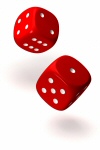

|
Gems from the world of Probability |
The game starts with
a set of participants arranged in a line from left to right where each
permutation is equally likely. There is a prize at the left end of the line.
Assume that a participant at place i
would see the prize if none of the participants preceding him/her
is taller than him/her.
A woman
can receive the prize only if she can see the prize and there is atleast
at-least one of the participants preceding her in the line is a child.
What is the expected number of women that would win the prize ?
Unfortunately, the first person in line is crazy, and will ignore the seat number on his ticket, picking a random seat to occupy. All the other passengers are quite normal, and will go to their proper seat unless it is already occupied. If their given seat is occupied, they will then find a free seat to sit in, (uniformly) at random. What is the probability that the last (nth) person to board the plane will sit in his/her proper seat (n)? (source : Amitabha bagchi)